NFL Playoffs: Secret Superstars of the wild-card round — the offense

If your team is going to win a Super Bowl, at some point along that ride, your team will have to get at least one remarkable postseason performance from a player nobody saw coming. Yes, we all expect the big names to come up big in big moments in big games, and other attendant cliches, but somewhere along the line, you will need a Secret Superstar to get the job done.
If you expected Buffalo Bills receiver Gabe Davis to go off for four touchdown catches against the Kansas City Chiefs in the 2021 divisional round, you should probably be working for a team. Because, with all due respect to Davis, I don’t think even the Bills were expecting that.
The same could be said for Houston Oilers defensive back Vernon Perry in the divisional round of the 1979 playoffs against the San Diego Chargers of Don Coryell and Dan Fouts. The undrafted rookie from Jackson State picked off four of Fouts’ passes, and blocked a field goal for good measure. As the game ended 17-14 in Houston’s favor, that block was as important as any of the picks.
You get the idea. At some point in the wild-card round of the upcoming playoffs, there will be at least one player whose name you don’t know who will pop up on the screen, and grab your attention. Here are my most likely players to do just that on the offensive side of the ball; the defensive players on this week’s Secret Superstars team will be up shortly.
And here’s the wild-card schedule for all who are curious; I tried to focus on repeat matchups as much as possible.
Brock Purdy, QB, San Francisco 49ers

(Joe Nicholson-USA TODAY Sports)
Not that Purdy is a secret at this point — we’ve all written and talked about his unlikely journey from the last pick in the 2022 draft to his current position as a quarterback with enough on the ball to actually help his 49ers team advance in the playoffs. And that the point: Purdy is far more than just an innocent bystander. That’s been the real surprise. Since Week 13, when he became the starter due to Jimmy Garoppolo’s broken foot, Purdy has the NFL’s best passer rating (112.0), completing 68.3% of his passes for 8.1 yards per attempt, 13 touchdown passes, and just three interceptions.
Purdy’s Week 14 game against the Seahawks marked his second NFL start, and in that 21-13 49ers win, he completed 17 of 26 passes for 217 yards, two touchdowns, no interceptions, and a passer rating of 117.0. An entirely efficient performance, and Purdy had a few explosive throws in that game that could prove troublesome for Seattle’s defense again.
The best Purdy play in that game was his double fake and 28-yard touchdown pass to tight end George Kittle with 3:36 left in the first quarter. It was this play that really showed us Purdy’s ability to live in a Kyle Shanahan offense that lives on matchup advantages and defensive displacement.
Tony Pollard, RB, Dallas Cowboys

(Photo by Tom Pennington/Getty Images)
Among running backs taking at least 50% of their teams’ snaps this season, only Aaron Jones of the Green Bay Packers (5.3) has a higher yards per attempt average than Pollard’s 5.2, and no back in the league has averaged more yards after contact per carry than Pollard’s 3.82. Imagine having to concede neatly four yards per carry after you get your hands on a running back. Pollard’s 17 carries of 15 yards or more ties him for third in the league with Kenneth Walker of the Seattle Seahawks (more on him in a minute), and he’s done this all as an equal-opportunity wrecker — he has 91 zone runs this season, and 91 gap runs.
So… you can talk all you want about Ezekiel Elliott; Pollard is as much of a key part of Dallas’ offense as anybody. He will fight for extra yards over the middle, but he’s also dynamic enough to do serious damage in the open field. This 21-yard run against the Jacksonville Jaguars in Week 15 on a pitch play was proof of concept.
Kenneth Walker III, RB, Seattle Seahawks

(Joe Nicholson-USA TODAY Sports)
If the Seahawks have any hope of beating the 49ers in Santa Clara, they’ll likely need a big game from Walker, their second-round rookie out of Michigan State who has looked better and better down the stretch. Walker ended the regular season with three straight high-volume games in which he ran the ball at least 23 times for at least 107 yards in each game. Walker has the NFL’s most rushing attempts (78) and the most rushing yards (354) in that three-game stretch, which is exactly what you’d expect from a back Pete Carroll trusts.
Walker also has five runs of 15 or more yards in that three-game stretch, but for the purposes of this particular matchup, here’s the 20-yard scamper he had against these very 49ers in Week 15. Once Walker bounces outside, he’s a real problem to corral because he has outstanding acceleration to the second and third levels of a defense.
Brandon Aiyuk, WR, San Francisco 49ers
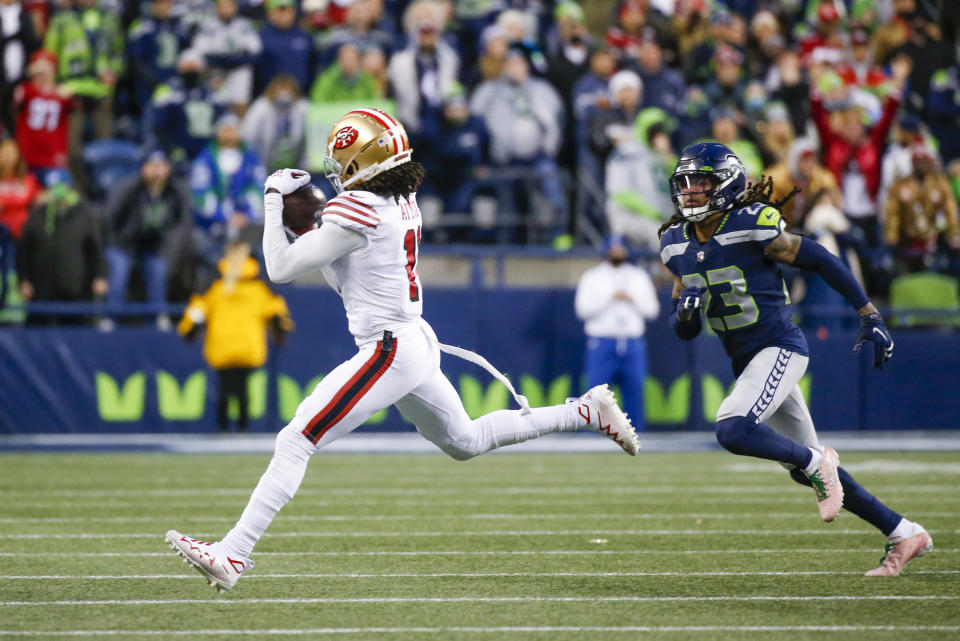
(Joe Nicholson-USA TODAY Sports)
Deebo Samuel missed Weeks 14-16 with a high ankle sprain, and given Samuel’s generally transcendent effect on Kyle Shanahan’s offense, it may surprise you to know that the 49ers actually have a better offensive EPA (0.07 to 0.02), passing EPA (0.14 to 0.04), and rushing EPA (0.02 to -0.02) when Samuel has been off the field. Brock Purdy’s ascent and the addition of Christian McCaffrey have a lot to do with it, but so does Brandon Aiyuk, who has become a receiver of high value in his third NFL season. The Arizona State alum has 78 catches on 114 targets for 1,015 yards — all of those numbers are team-leading — and his eight receiving touchdowns puts him behind only George Kittle.
Aiyuk was more than happy to help his rookie quarterback early in Purdy’s on-field development; this 32-yard touchdown against the Buccaneers in Week 14 had Aiyuk just devastating cornerback Jamel Dean on what probably should have been a fade ball — once Aiyuk gauged that Purdy didn’t quite have the velocity on the ball that should have been, he was savvy enough to come back for the ball, and to get into the end zone.
The Seahawks should have all kinds of fun trying to figure out who’s getting the ball now that they have to deal with Samuel, Kittle, McCaffrey, and Aiyuk at the same time. So should any other team having to face the 49ers in the playoffs.
Mike Williams, WR, Los Angeles Chargers

(Jayne Kamin-Oncea-USA TODAY Sports)
Sometimes, you really get a sense of how valuable a player is to a team when he’s not on the field for a while. That’s been the case for Williams, who has missed four full games this season with injuries, and has played 675 snaps to 460 off the field. When Williams is in the game, the Chargers’ passing EPA rises from -0.08 to +0.04, their average depth of target jumps from 5.8 to 6.7, the team’s catch rate goes from 68.5% to 72.1%, and Justin Herbert’s EPA per play goes from 0.02 to 0.12.
So, when your passing game is both more efficient and explosive with a particular receiver on the field, that receiver must be pretty good. Williams can catch the ball deep when he’s given the opportunity, but he’s also an after-the-catch threat, and he has an excellent understanding of where and how to break open in any kind of coverage. The Indianapolis Colts discovered how well Williams can do all these things on this 26-yard play in Week 16 in which 13 yards came after the catch.
Christian Kirk, WR, Jacksonville Jaguars
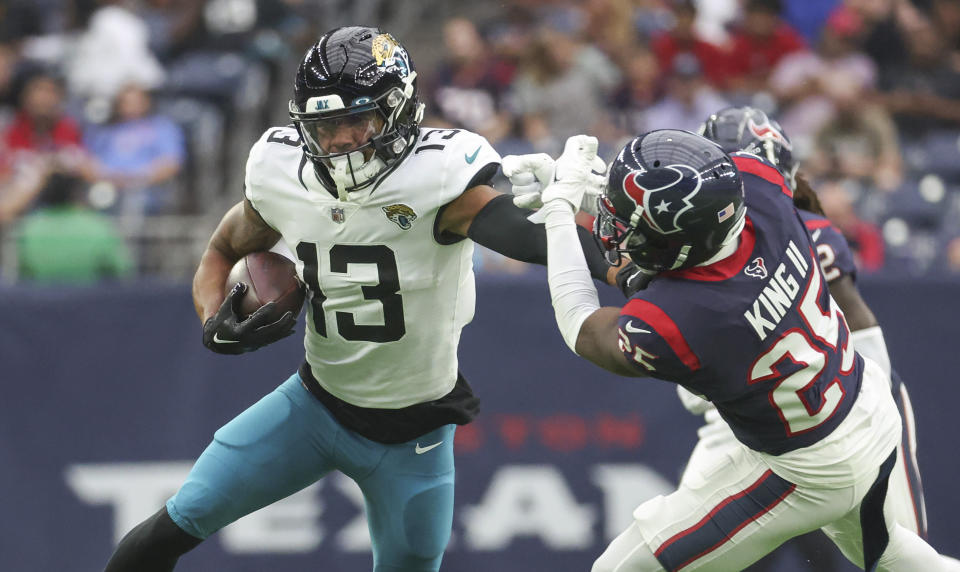
(Troy Taormina-USA TODAY Sports)
A lot of people were wondering just what the heck the Jaguars were doing this past offseason when they signed Kirk — who had never attained a 1,000-yard season in four years with the Arizona Cardinals — to a four-year, $72 million contract with $37 million guaranteed.
One regular season later, with Kirk catching 84 passes on 133 targets for 1,108 yards and eight touchdowns (all career highs), and that contract looks a lot more amenable. Trevor Lawrence now has an estimable group of targets in Kirk, Zay Jones, Marvin Jones, and tight end Evan Engram (who we’ll soon discuss in more detail), but Kirk has been the legit No. 1 receiver the Jaguars thought he could be.
What do you want from a legit No. 1 receiver? The ability to win outside deep is certainly at or near the top of the list. Kirk has done that, and his ability to find holes in coverage with deep posts and overs is particularly interesting. The Kansas City Chiefs found that out in Week 10. when Kirk beat their Cover-1 defense for a 24-yard catch on the deep crosser.
Evan Engram, TE, Jacksonville Jaguars

(Syndication: Florida Times-Union)
The New York Giants selected Engram with the 23rd overall pick in the 2017 draft out of Mississippi, and while he showed flashes with his first NFL team over five seasons — he made the Pro Bowl in 2020, for what it’s worth — he never really became the dominant weapon at the position the Giants wanted him to be. So, he was available for the Jaguars, who signed him to a one-year, $9 million contract before the 2022 season. Engram hasn’t been The Guy in Jacksonville’s offense either, but Doug Pederson and the Jags’ coaching staff have done an excellent job of putting Engram’s pure speed in motion as an asset. Engram’s 97 targets ranked fifth among tight ends in the regular season, and he tied with four other tight ends with the league’s third-most catches of 20 or more air yards, with four.
Two of Engram’s four touchdowns this season came against the Tennessee Titans in Week 14, and this touchdown should be of particular interest to the Chargers’ defensive players and coaches. Engram put cornerback Andrew Adams in a disadvantageous position with a nasty inside-out move, and the speed to get to the end zone. Then, Engram used his 6-foot-3, 240-pound frame to win the contested catch.
Noah Fant, TE, Seattle Seahawks

(Jayne Kamin-Oncea-USA TODAY Sports)
Speaking of former first-round tight ends who found new opportunities with their second NFL teams… Fant was one of the three Broncos players (along with quarterback Drew Lock and defensive lineman Shelby Harris) sent to Seattle in the Russell Wilson trade, and he’s been the most impactful to date. Part of the reason for this is that the Seahawks love to create downfield with multiple tight ends — Geno Smith has been especially transcendent on deep passes with two tight ends in the formation, with an NFL-high eight completions and four touchdowns of 20 or more air yards.
Against the Arizona Cardinals in Week 9, Fant showed that he can also create after the catch on short passes. This was a three-tight end set with Will Dissly and Colby Parkinson also on the field, and Fant rolled from left to right, took the simple swing pass, and beat several Arizona defenders for a 51-yard play.
Walker Little, LT, Jacksonville Jaguars
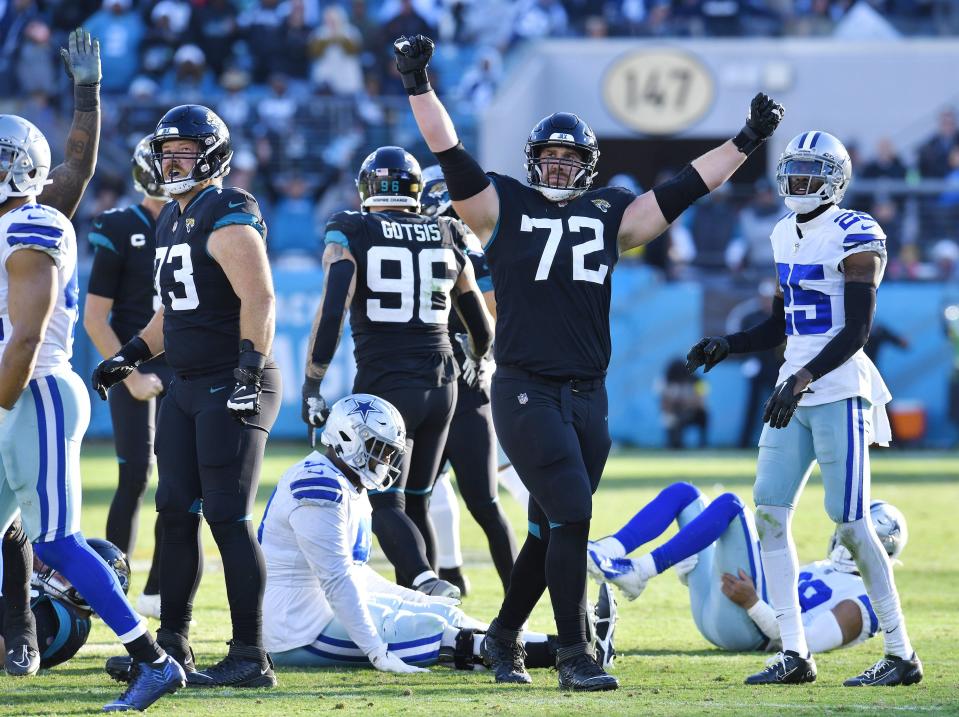
(Syndication: Florida Times-Union)
A number of injuries limited Little’s time at Stanford, but when he was on the field in college, he put together (in my opinion) the best overall pass sets of all the tackles in the 2021 draft class. The Jaguars selected him with the 45th pick in the second round of that draft, and Little has proven his value in Jacksonville’s final three regular-season games when he became the starting left tackle after Cam Robinson was lost for the rest of the season to a torn meniscus in Week 15. Little has allowed one sack, one quarterback hurry, and six quarterback hits in three starts against the Jets, Texans, and Titans, so he’ll certainly be on point against the Chargers’ estimable pass rush.
What’s impressed me late in the season is how well Little has blocked to help open things up in Jacksonville’s run game. Travis Etienne doesn’t get this 19-yard run against the Jets without Little pulling from left to right, and putting defensive lineman John Franklin-Myers (one of the NFL’s most underrated players) on his heels.
Jamaree Salyer, LT, Los Angeles Chargers

(AP Photo/Kyusung Gong)
The Chargers certainly didn’t expect Salyer to be their starting left tackle for most of his rookie season — were that the case, they would have taken the Georgia alum much earlier in the 2022 draft than the 195th pick in the sixth round. Nonetheless, when Rashawn Slater went down in Week 3 against the Jaguars with a torn biceps, Salyer was thrown into the fire, and after a few early rough spots, he’s responded well to the challenge. Since Week 14, he’s allowed one sack, five quarterback hits, and 12 quarterback hurries.
Not that the Chargers sling the ball deep as much as you’d like, but Salyer has become the kind of pass-blocker who can help Justin Herbert collect the time he needs to create explosive plays. In Week 14 against Bradley Chubb of the Miami Dolphins, Salyer enveloped Chubb at the line of scrimmage, and that gave Herbert the clean pocket he needed to align with the aforementioned Mike Williams 23 yards downfield.
Slater won’t be back for the wild-card round, but he might be ready for the divisional round if the Chargers advance. In that case, perhaps the Chargers move Salyer to right tackle, which would solidify a positional issue this team has had for a while.
Damien Lewis, LG, Seattle Seahawks
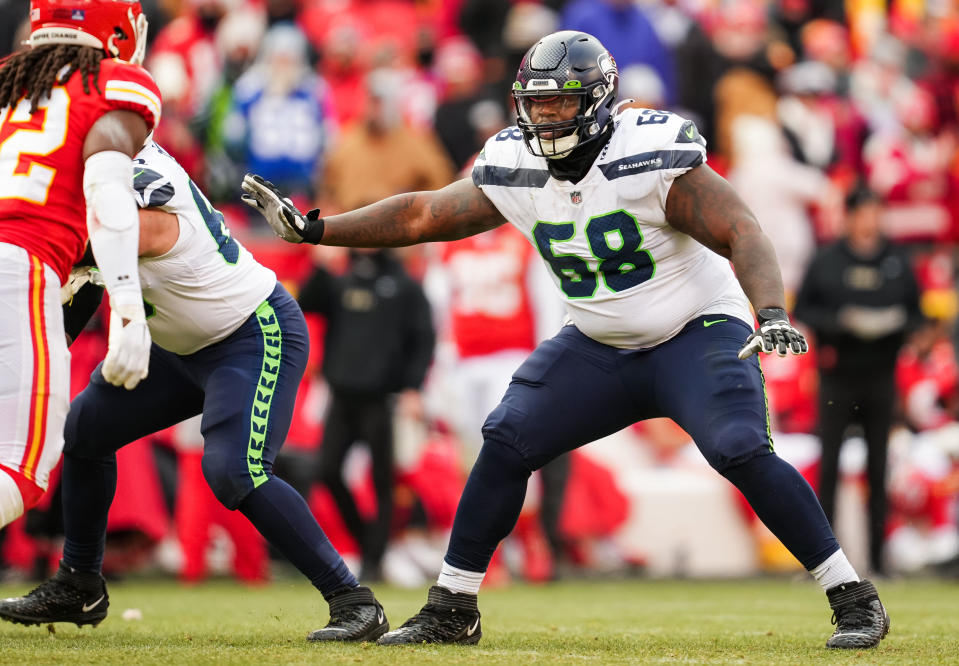
(Jay Biggerstaff-USA TODAY Sports)
Seahawks first-year offensive tackles Charles Cross (left) and Abe Lucas (right) started their inaugural NFL campaigns strong, but both have hit the rookie wall to a point, and that’s one reason Geno Smith has taken 19 sacks over six games in the months of December and January. That’s a problem when you’re having to deal with Nick Bosa in the playoffs.
The good news among Seattle’s offensive line is that Damien Lewis, the third-year man from Louisiana State, has really shored up his game of late after some rough spots earlier in the season. The Arizona Cardinals ate Lewis’ lunch for two sacks in Week 6, but Lewis has allowed just one sack since then — and since Week 14, he’s given up no sacks, one quarterback hit, and three quarterback hurries. That’s with everything collapsing around him at a relative rate.
Of course, this is the Seahawks we’re talking about here, so we want to study how well Lewis operates in the run game. This 11-yard Kenneth Walker run against the Chiefs in Week 16 is a positive example — No. 68 got to the second level as Walker started to bounce outside, and Lewis was able to latch onto linebacker Nick Bolton just enough to take Bolton out of the play.
Corey Linsley, C, Los Angeles Chargers
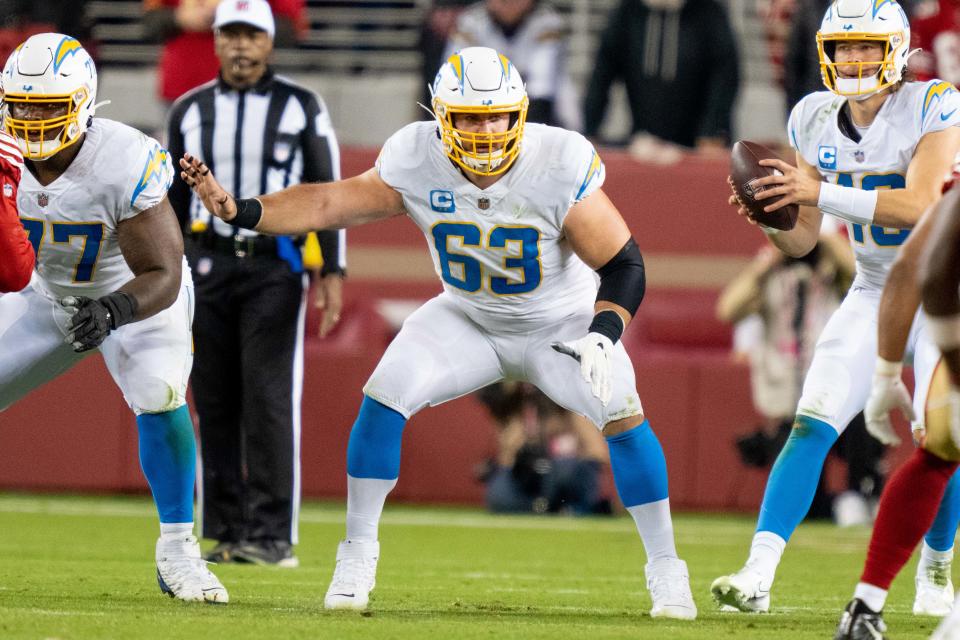
(Kyle Terada-USA TODAY Sports)
The Chargers signed Linsley, the former Green Bay Packers standout, to a five-year, $62.5 million contract with $27 million guaranteed before the 2021 season because they wanted to solve a position that had been a dumpster fire for them before. In 2020, Dan Feeney allowed four sacks and 33 total pressures for the Chargers in 729 pass-blocking snaps.
Over the last two seasons, Linsley has taken 1,276 passing snaps, and he hasn’t allowed a single sack on any of them. If you think that’s not a big deal, and that centers don’t give up a ton of sacks, ask the Cleveland Browns (Hjalte Froholdt) and the Houston Texans (Scott Quessenberry), each of whom had centers who allowed seven quarterback takedowns this season.
Linsley has never been a pure power guy, but he’s so technique-sound, he doesn’t have to be. Watch how he mirrored Tennessee Titans defensive tackle Jeffery Simmons on this insane Justin Herbert 31-yard throw to Keenan Allen in Week 15. As much as you’d like to see the Chargers throw more deep passes into their playbook… well, Linsley is one reason they’re pretty good with it when they do.

